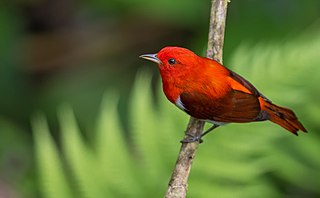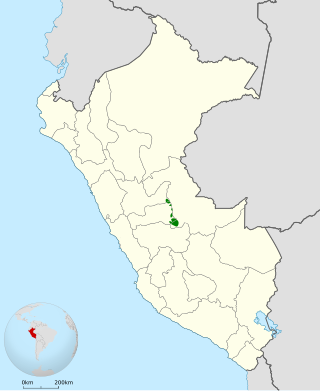
The golden-hooded tanager is a medium-sized passerine bird. This tanager is a resident breeder from southern Mexico south to western Ecuador.

The silver-throated tanager is a species of passerine bird in the tanager family Thraupidae. It is found in Costa Rica, Panama, Colombia, Ecuador, and northeastern Peru. It inhabits mossy forests, montane evergreen forests, tropical lowland evergreen forests and forest edges, along with tall secondary forests and disturbed habitat with remnant trees and forest. It is 13 centimetres (5.1 in) long and weighs 22 grams (0.78 oz) on average, and shows slight sexual dimorphism, with duller female plumage. Adult males are mainly bright yellow, with a silvery-white throat bordered above with a black stripe on the cheeks, black streaking on the back, and green edges to the wings and tail. Juveniles are duller and greener.

Tangara is a large genus of birds of the tanager family. It includes 27 species. All are from the Neotropics, and while most are fairly widespread, some have small distributions and are threatened. They are fairly small, ranging in size from 11.5–15 centimetres (4.5–5.9 in). This genus includes some of the most spectacularly colored birds of the world.

The fawn-breasted tanager is a species of tanager with a blue head and yellow breast. It occurs in the Andes of northwestern Argentina, Bolivia, Colombia, Ecuador, Peru and Venezuela, as well as in the highlands of northeastern Argentina, south Brazil, Paraguay and Uruguay.

The gold-ringed tanager is a species of bird in the family Thraupidae, endemic to Colombia. It is a plump, relatively short-tailed Tanager with a distinctive gold ring around its face. It inhabits a narrow band of high-altitude cloud forest on the slopes of the western cordillera of the Andes, where it survives on a diet of fruit and insects. The bird is found in small numbers within a limited geographical area, and much of its breeding biology has yet to be described. It is considered a vulnerable species, threatened by habitat loss.

The golden-chested tanager is a species of bird in the family Thraupidae. It is found in Colombia and Ecuador. Its natural habitats are subtropical or tropical moist lowland forests and subtropical or tropical moist montane forests.

The plushcap is a species of bird in the tanager family Thraupidae and it is the only member of the genus Catamblyrhynchus.

The scarlet-and-white tanager is a species of bird in the family Thraupidae. It is found in Colombia and northern Ecuador. Its natural habitats are subtropical or tropical moist lowland forests and heavily degraded former forest. The male is highly distinctive and has bright scarlet upperparts, darker red wings and undertail coverts, and white underparts with a scarlet median stripe running down the throat and belly. Females are patterned like the males, but are olive-brown instead of scarlet.

The blue-necked tanager is a species of bird in the family Thraupidae. It is found in South America from Colombia to Bolivia.

The blue-browed tanager is a species of bird in the family Thraupidae. It is found in Bolivia, Colombia, Ecuador, and Peru. Its natural habitat is subtropical or tropical moist montane forests.

The emerald tanager is a species of bird in the tanager family Thraupidae. It is found in Colombia, Costa Rica, Ecuador, and Panama. Described by the English ornithologists PL Sclater and Osbert Salvin in 1869, it is a medium-sized species that has a length of 10.6–13 cm (4.2–5.1 in) and a mass of 18–20.5 g (0.63–0.72 oz). It can be identified by its bright green plumage, with black streaking on the back and wings, and a black auricular patch and beak. It also has yellow on the crown and rump. The species shows slight sexual dimorphism, with the females being duller and having yellow-green in place of yellow on the head.

The metallic-green tanager is a species of bird in the family Thraupidae. It is found in Colombia, Ecuador, and Peru. Its natural habitat is subtropical or tropical moist montane forests.

The flame-faced tanager is a species of bird in the tanager family Thraupidae. It is endemic to South America and is found in the eastern Andes of Colombia, Ecuador, Peru and Venezuela. Its natural habitat is subtropical or tropical moist montane forests. It is a distinctive-looking species with black and opalescent green upperparts, opalescent green and buff underparts, and a deep red and yellow face. The subspecies lunigera lacks the deep red on the face, which is replaced with orangish-red.

The Sira tanager is a species of bird in the family Thraupidae. It is endemic to Peru and exists only in the Sira range.

The golden-naped tanager is a species of bird in the tanager family Thraupidae. It is found in South America from Colombia to Bolivia. Its natural habitats are subtropical or tropical moist montane forests and heavily degraded former forest.

The blue-and-black tanager is a species of bird in the tanager family Thraupidae. It is found in the Andes of Bolivia, Colombia, Ecuador, Peru and Venezuela, where it inhabits montane evergreen forest, dwarf forest, and secondary forest at elevations of 1,500–3,500 m (4,900–11,500 ft). It inhabits the highest altitude of any Tangara species, and is the only species from the genus that is found near the tree line. Adults are 13 cm (5.1 in) long and weigh 18 g (0.63 oz) on average, and are mostly blue with black masks, wings, and tails. The species shows slight sexual dimorphism, with females being slightly duller than males.

The scrub tanager is a species of bird in the family Thraupidae.

The saffron-crowned tanager is a species of bird in the family Thraupidae. Found in the northern Andes of Bolivia, Colombia, Ecuador, Peru, and Venezuela, it inhabits cloud forest, forest edges, and secondary forest, preferring areas with mossy trees. It is an average-sized species of tanager with a blue-green body and yellow head with a black forecrown, lores, orbital area, and chin.

The blue-throated hillstar is a hummingbird found only in a small portion of the southwestern Andes in Ecuador. It was discovered in 2017.

Stilpnia is a genus of Neotropical birds in the tanager family Thraupidae.
























